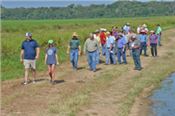|
Researchers Use Test Plots To Adapt Recommendations

Participants at the Northeast rice field day held south of Rayville, Louisiana, listen to LSU AgCenter expertS giving advice on growing this year’s crop.
Photo by Bruce Schultz, LSU AgCenter
RAYVILLE, LA.
The differences in growing rice in north and south Louisiana create the need for researchers to study how farmers can adapt their practices to fit the varied environments, an LSU AgCenter expert said.
Speaking at the Northeast Louisiana rice field day, LSU AgCenter rice breeder Steve Linscombe said test plots on farmers’ land help test potential rice varieties to see how the perform in different settings with varying soil types and climates.
The field day was held at the Woodsland Plantation south of Rayville where Linscombe has a series of test plots.
Among the rice included in the test plots are two lines that could become varieties this year, he said.
The line LA2134 has a yield potential similar or perhaps higher than CL151 with better grain quality, better lodging resistance and more blast disease resistance, he said. A seed increase grown in Puerto Rico has been planted in a 20-acre field at the LSU AgCenter Rice Research Station near Crowley.
Also up for consideration as a release is a medium-grain line, LA2008, he said.
Blast is a problem for some growers this year, although it is not as bad as in 2012, Linscombe said. The severity may have been reduced this year because farmers are using fungicides more effectively.
Bacterial panicle blight has been found in the varieties CL111 and Jazzman 2, Linscombe said. Sheath blight problems are about average.
Check-off funds paid by farmers are essential for rice research and to buy equipment researchers need to do their work, Linscombe said. “These check-off funds are extremely valuable to bring new technology to the station.”
The new rice breeder at the station, Adam Famoso, said he wants to use technology to screen new rice lines earlier in the breeding process to obtain desired traits and to eliminate unwanted characteristics.
AgCenter rice specialist Dustin Harrell said this year’s growing season will be remembered for heavy rainfall that kept soil wet and interfered with fertilizer applications.
“Pre-flood nitrogen has to go out on dry ground, or you’re going to lose much of that nitrogen,” Harrell said.
AgCenter entomologist Sebe Brown said keeping levees clear of weeds can slow the migration of stink bugs into a field. Acephate cannot be used legally for stink bugs, and traces of the pesticide found on rice can be rejected by overseas buyers.
Stink bugs probably will become resistant to pyrethroids eventually, Brown said. “It’s not if, but when.”
Rogers Leonard, AgCenter program leader for plants and soils, said the recent legislative session ended with a resolution of a potential funding crisis that could have led to closures of AgCenter research stations and parish extension offices.
Leonard credited legislators for realizing the potential for disaster and voted for items they disliked to prevent the drastic action. “We will try to thank them as much as we can.” ∆
|
|